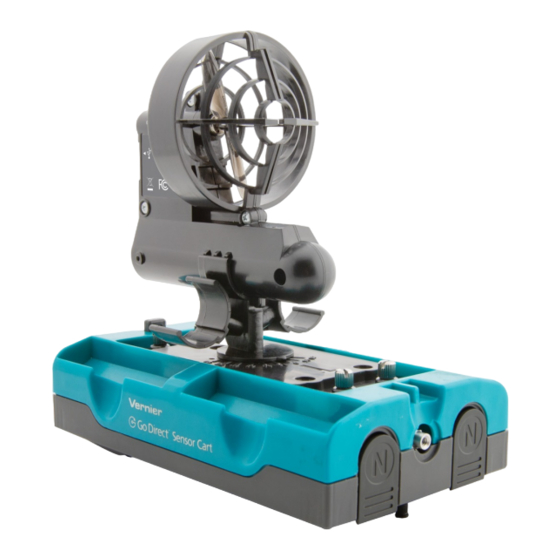
Advertisement
Quick Links
Cart Fan
(Order Code DTS-CFAN)
The Cart Fan is a modular fan you can mount
on Vernier Dynamics Carts and Go Direct
Sensor Carts that allows students to perform
kinematics and dynamics experiments. Using
one or multiple fans on a single cart allows students to investigate constant
acceleration, balanced/unbalanced forces, and variable thrust angles.
Note: Vernier products are designed for educational use. Our products are not
designed nor are they recommended for any industrial, medical, or commercial
process such as life support, patient diagnosis, control of a manufacturing
process, or industrial testing of any kind.
What's Included
Cart Fan
l
Mounting Plate and mounting screws
l
Micro-USB cable
l
Assembly
1. Connect the Mounting Plate to the Dynamics or Go Direct Sensor Cart:
If you are using a Go Direct Sensor Cart, use the four corner screws to
l
attach the Mounting Plate to the four corner threaded holes in the top of the
Sensor Cart.
If you are using a Dynamics Cart, use two half-inch 10-32 screws to
l
connect the Mounting Plate to the Low-g Accelerometer holes on the cart
surface. For additional security, use the half-inch ¼"-20 screw to connect
the Mounting Plate to the DFS hole.
2. Insert the Cart Fan(s) into the appropriate mounting position(s) for your
experiment. The Cart Fan can be mounted pointing forward or backward. The
mounting bracket can be pointed off axis in 15 degree intervals.
Charging the Sensor
The Cart Fan arrives in a low battery state and may not be able to run on the
higher thrust level without first charging for several hours.
Connect Cart Fan to the included Micro USB Cable and any USB device. An LED
next to the USB port on the Cart Fan indicates charging status.
Orange LED next to battery icon is solid while
Charging
sensor is charging.
Fully charged
Green LED next to battery icon is solid when
sensor is fully charged.
®
Powering the Cart Fan
Press the Start/Stop button once. When the unit is on, the
Turning on the
Thrust/Duration indicator LEDs are on and solid.
Cart Fan
Press and hold the Start/Stop button for three seconds or
Turning off the
more to turn the Cart Fan off. The Thrust/Duration indicator
Cart Fan
LEDs turn off when the unit is off. If the Cart Fan sits idle
for more than 2 minutes, it will automatically turn itself off.
Using the Cart Fan
The Cart Fan can be placed in any of the three brackets in the Mounting Plate;
they are molded to attach firmly. When using a single Cart Fan, it is recommended
that it is placed in the middle bracket.
Typical Operation of the Cart Fan
1. Press the Start/Stop button to turn on the Cart Fan.
2. Use the Selection button to select the desired thrust. As you press the Selection
button, the Thrust/Duration LEDs will light green and indicate the thrust level.
3. Press and hold the Selection button for two seconds to switch to duration
selection. The Thrust/Duration LEDs will switch to red. As you press the
Selection button, the Thrust/Duration LEDs will indicate the duration.
4. Press the Start/Stop button to start the Cart Fan. The Thrust/Duration indicator
LEDs will flash orange as the Cart Fan counts down 2 seconds until the fan
starts.
Indicator LEDs Thrust (Red) Duration (Green)
1
2
Medium
3
High
4
Super
The Cart Fan thrust levels were selected so that even at the lowest setting, they are
much greater (~20×) than that of a dynamics cart's rolling friction. The thrust
increases by about 25% with each increase in level. For most experiments, the
medium thrust level is sufficient. It is recommended that students measure thrust
levels themselves in their experimental setup before completing any task where
high precision is required.
Thrust levels vary from unit to unit. When using multiple fans to multiply the net
force on a single cart, slight variations in thrust are insignificant. But when using
multiple fans to show balanced/unbalanced forces, variation from unit to unit will
be more obvious. For example, two fans set to the same thrust level and pointed in
1
Low
1 s
6 s
12 s
60 s
Advertisement

Subscribe to Our Youtube Channel
Summary of Contents for Vernier DTS-CFAN Series
- Page 1 Using the Cart Fan Note: Vernier products are designed for educational use. Our products are not The Cart Fan can be placed in any of the three brackets in the Mounting Plate; designed nor are they recommended for any industrial, medical, or commercial they are molded to attach firmly.
- Page 2 Vernier Science Education 13979 SW Millikan Way • Beaverton, OR 97005-2886 your Cart Fan, contact Vernier Technical Support at support@vernier.com or call Toll Free (888) 837-6437 • (503) 277-2299 • Fax (503) 277-2440 888-837-6437. Support specialists will work with you to determine if the unit info@vernier.com •...
Need help?
Do you have a question about the DTS-CFAN Series and is the answer not in the manual?
Questions and answers